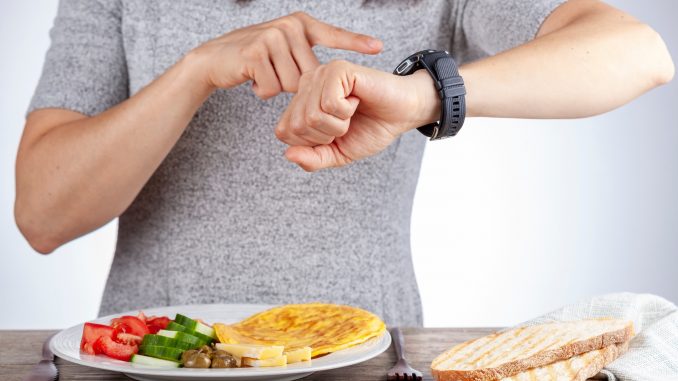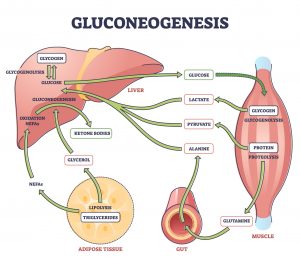
Gluconeogenesis is the process by which the body is able to produce glucose from a host of non-carbohydrate sources. It occurs mostly in the kidney and liver and in both mitochondria and cytoplasm. The pathway is also one that operates especially during fasting when no glucose has been consumed in the form of carbohydrates. One tissue that cannot do gluconeogenesis is skeletal muscle so being able to to produce glucose for the purposes of ‘feeding’ such muscle is vital. Skeletal muscle does not have the enzyme glucose-6-phosphatase which we will see is critical in this pathway. Maintaining glucose levels in the blood is important too so that we don’t fall into a hypoglycaemic state i.e. a situation where blood glucose drops below its normal range. The process of maintaining the balance is called euglycaemia.
Gluconeogenesis is almost the reverse of glycolysis but it is not a direct reverse because as a pathway there are a few steps that are different. Pyruvate is a key metabolite because it can be derived from a variety of sources and it is the starting point for gluconeogenesis. One major contributor is the amino-acid alanine from the Cahil cycle and another is lactate from the Cori cycle. It implies that pyruvate can be derived from a non-carbohydrate source.

Whilst the reverse pathway is similar there are three parts of the pathway that are different from pyruvate to glucose otherwise the rest is the same but in reverse to glycolysis (cannot emphasise these points enough!)
The first different step is the conversion of pyruvate into oxaloacetate. It requires a pyruvate carboxylase as the catalyst. The next step is the conversion of oxaloacetate to phosphoenolpyruvate (PEP) using the enzyme phosphoenolpyruvate carboxykinase.
The second different step is the conversion of fructose-1,6-bisphosphate to fructose-6-phosphate catalysed by the enzyme fructose-1,6-bisphosphatase. This reaction is the removal of one of the two phosphate groups.
The third and final different step is converting glucose-6-phosphate back to glucose (the starting point of glycolysis). The enzyme needed here is glucose-6-phosphatase for catalysis.
The principal reason why there are three differences in the step to reconvert pyruvate back to glucose is because of the energy system in fasting. There is simply not enough ATP available for the reverse reactions during this metabolic state. The reason for generating glucose is to maintain the state of euglycaemia or a constant blood glucose level within the normal range. The glucose then can be used for further ATP synthesis using ironically glycolysis or some other metabolic process especially when the body is in a fasting metabolic state. These three different steps are the result of an evolutionary system that has led to a metabolic process able to use non-carbohydrate sources for generating this energy.
Gluconeogenesis is a highly regulated metabolic pathway as is glycolysis. The high degree of regulation is to prevent the wasteful use of pyruvate and glucose in a never ending cycle which uses up ATP and other cofactors needlessly. The presence of the four key unique enzymes in gluconeogenesis means that their regulation will prevent using up scare resources especially when cells require energy and substrates for other processes.
The rate-limiting step in gluconeogenesis is the fructose-1,6-bisphosphatase (FBPP). There are a few substrates that activate and inactivate this enzyme. Citrate for example activates the enzyme whilst AMP and fructose-2,6-bisphosphate reduce its activity. When the body has been fed, you have readily available glucose from carbohydrates which can be used. In glycolysis, the levels of fructose-2,6-bisphosphate rise so it is a way of suppressing gluconeogenesis because it is simply not required. (It makes sense that only one pathway is needed at any one time).
In the first step, pyruvate carboxylase is activated by acetyl CoA and require biotin. PEP carboxykinase requires GTP.
It is understandable that both citrate and acetyl-CoA would inhibit glycolysis if they are already readily available. It would make sense to promote gluconeogenesis.
The other factor that promotes gluconeogenesis is the role of hormones that are produced in response to the metabolic state of the cells. There is a carful balance between the level of insulin versus glucagon. Insulin promotes glycolysis. The hormone glucagon promotes the synthesis of glycogen which is stored in animal tissues such as muscle and in doing so inhibits glycolysis.
Leave a Reply